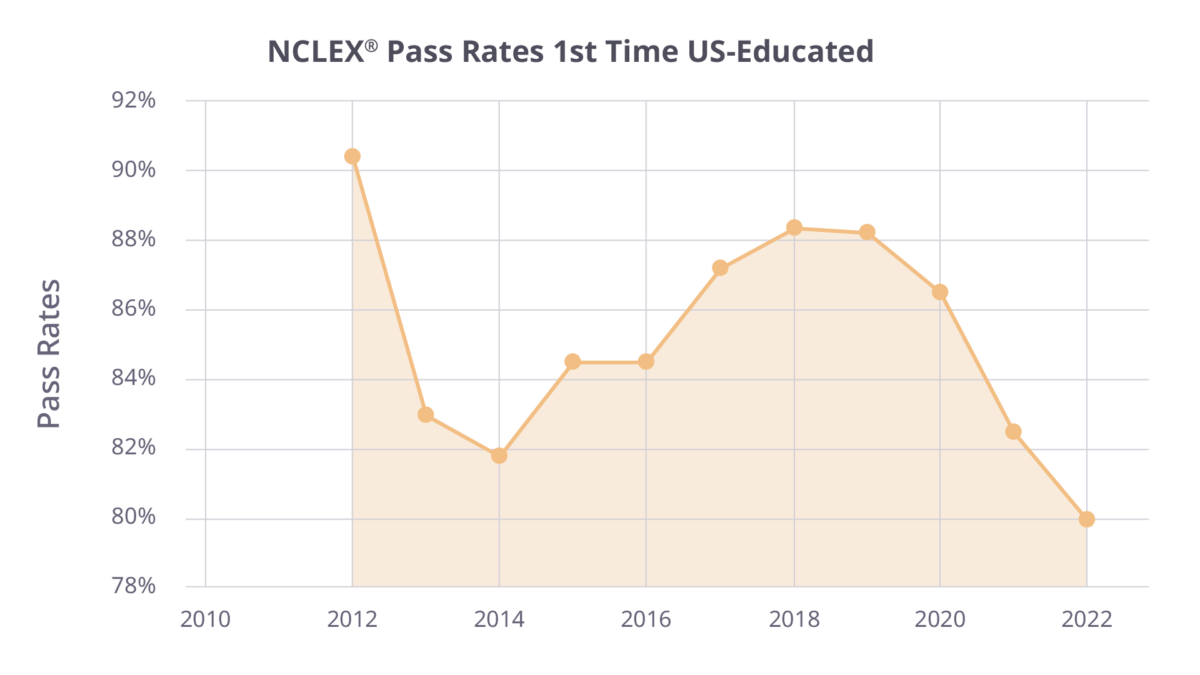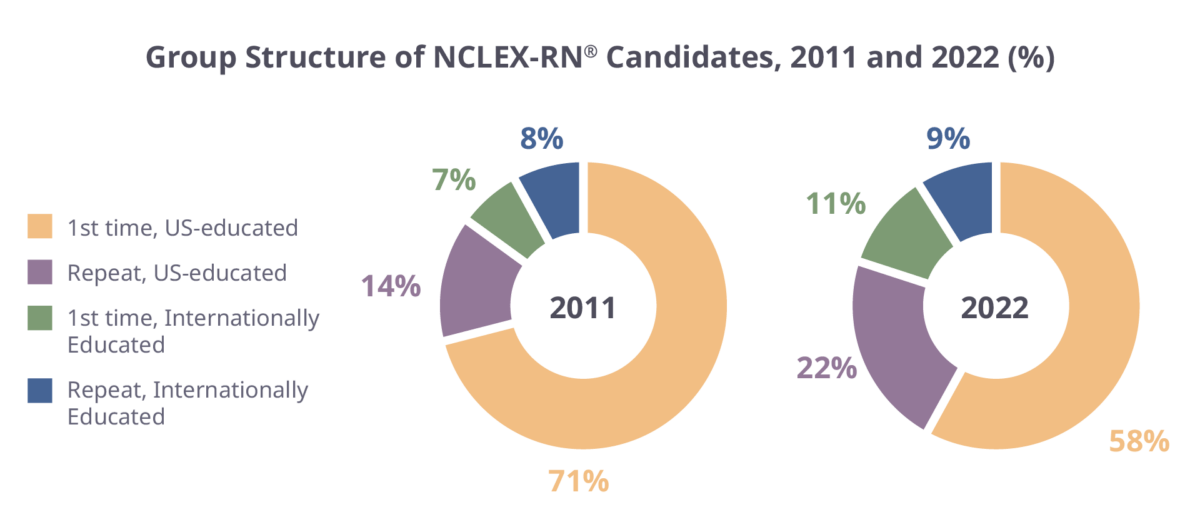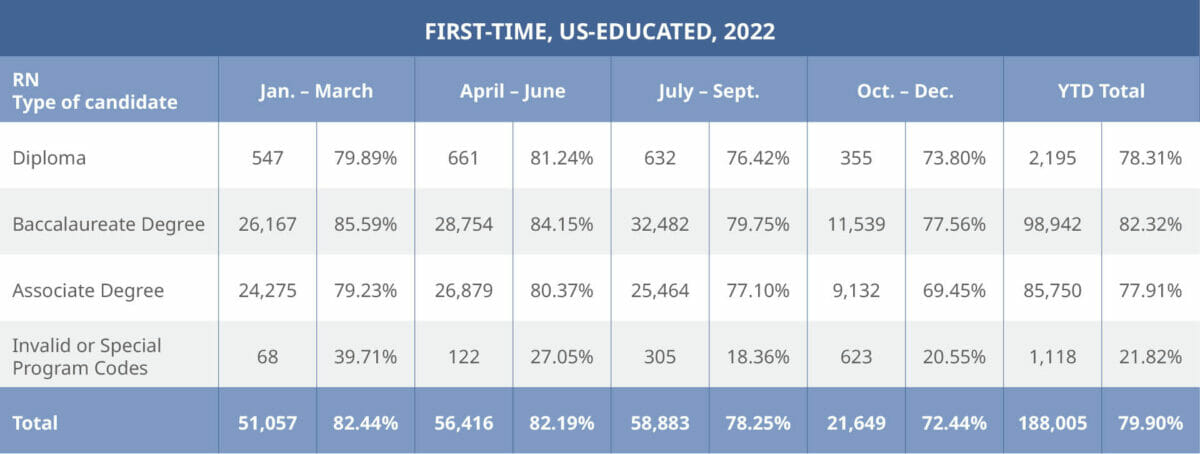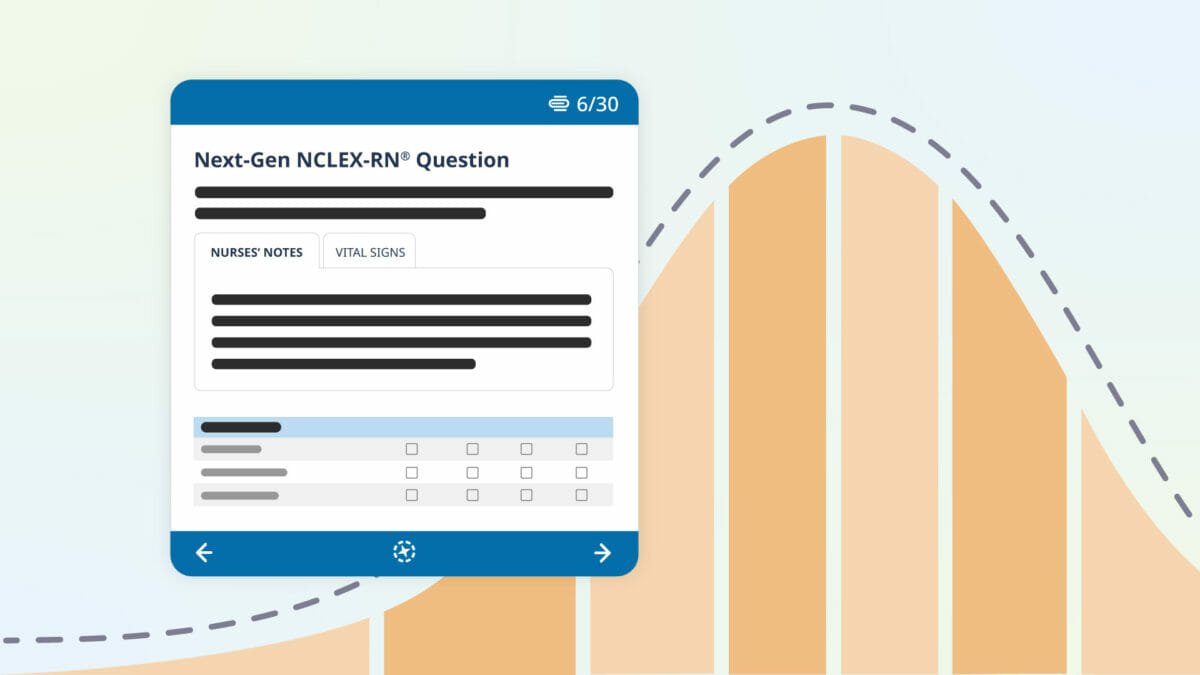As the first results from the Next-Gen NCLEX-RN become visible, educators will be examining pass rates closely, especially in the context of the US nursing shortage. While the NCLEX is reviewed continuously and revised every three years to ensure the accuracy of content and to reflect current practices, in years following a change in passing standards, scores have traditionally dropped and then recovered before the next revision. For example, a drop and subsequent recovery occurred following the changes in 2013 and 2019 (NCLEX Pass Rates, n.d.). While the Next-Gen NCLEX-RN is lauded for its emphasis on critical judgment, it is hard to predict what changes we will see in 2023, and whether they could change, either positively or negatively, in a manner similar to or even greater than the decline seen following the NCLEX revision in 2013 when the passing standard was raised for the NCLEX-RN.
Since that time, there have been fluctuations in both the number of candidates taking the exam and the pass rates of those candidates. In this article, we will review these changes in the NCLEX passing rate over the past decade along with the increase in test-takers and explore possible explanations for the trends we observe.
Declining Pass Rates

US: first-time exam takers
US-educated first-time exam-takers make up the largest group who take the NCLEX-RN, but their growth rate is slower than the other groups. This group also has the highest pass rate among all candidates. However, their pass rate has been declining over the years, with a 7.5% decline since 2010. Notably, even this decline is less than the overall decrease in pass rates, which shows that this group has maintained a relatively strong pass rate when compared to other groups.
Group Structures of Test Candidates

Within the US, pass rates for first-time BSN test takers are 9 percentage points lower than they were four years ago, going from 91% passing in 2019 to only 82% in 2022. For first-time ADN test-takers, the pass rates drop 8 percentage points during the same time period, going from 85% in 2019 to 77% in 2022. For both of these programs, pass rates steadily declined over this four-year period.

Overall, this decline in passing rates could possibly be explained by the sudden shift to online learning in March 2020. Another explanation could be that passing rates may have also been affected by the pressures placed on nurses (including nursing faculty) during the worst of the COVID-19 pandemic. Either or both of these explanations, in combination with the changes made to the NCLEX-RN exam in 2019, could have had a negative effect on passing rates.

Other groups of test takers
US repeat exam-takers have a lower record of success, with only 2 out of 5 people passing the exam on their subsequent try. This is far lower than the repeat pass rate a decade ago, with the pass rate for US repeat exam takers declining more than 11 percentage points since 2010. The high rate of failure among US repeat exam-takers calls for an increase in remediation resources and strategies.
Internationally-educated first-time exam-takers make up the second biggest group and have grown 2.4 times in size since 2010. This group grew by 15% in just 2022, which might reflect a trend of more international healthcare workers coming to the US. However, this growth might also be a temporary effect of candidates taking the NCLEX before it changed. Internationally-educated candidates show growth in pass rates, but the share of successful results stays low, with only 2 out of 5 candidates passing the test on their first attempt. Repeat exam-takers in this group show even lower pass rates, with no more than 3 out of 10 people passing the test. While this trend could be due to language barriers, these candidates would also benefit from remediation programs.
The global total of candidates taking the exam has increased significantly over the past decade. The overall number of NCLEX-RN candidates has risen from 197,775 in 2010 to 321,556 in 2022—an increase of 63% in twelve years. The number of candidates taking the exam in 2022 rose unexpectedly high in comparison to 2021, with a 15% increase overall (NCLEX Pass Rates, n.d.). However, this increase should be viewed in light of a 90% increase in internationally-educated first-time test takers. We see at least two possible explanations for this dramatic rise in the number of first-time test takers. The first is that many candidates wanted to take the exam before the switch to Next Gen NCLEX-RN (NGN). The second possible explanation may rest with state measures (such as expedited work permit renewals) implemented in an attempt to attract and keep more healthcare workers coming from outside the US.
Conclusions
Based on the previous NCLEX updates and declines in 2013, it is hard to predict whether the Next Gen NCLEX-RN could have a similarly large effect on pass rates.
The declining pass rates among US-educated repeat exam-takers suggest that remediation programs need to be reevaluated and improved. Strategies such as intensive review programs that include practice question banks that are tailored to student problem areas, such as customized learning paths, have proved effective for student remediation (Meehan & Barker, 2021).
The trend of internationally educated healthcare workers coming to the US is likely to continue, and in order for registered nurses to make up part of their number, these candidates must have access to the resources and support they need to succeed on the NCLEX. This includes offering test prep materials in more languages, assigning (and providing access to) more mock tests to raise their confidence levels, paying more attention to remediation practices, and ensuring that these candidates can easily reach out to educators for assistance.
If we are to address the nursing shortage, it is crucial to provide students with the necessary resources and tools to prepare for this new format. Putting strategies in place such as better remediation programs for repeat test-takers and more support for internationally educated candidates could improve pass rates over time and ensure that more nurses are able to successfully obtain their licenses. Adjusting programs to teach clinical judgment, providing educators with relevant question banks, and offering more NGN test prep materials can support all students to prepare for and succeed with the new exam format.



